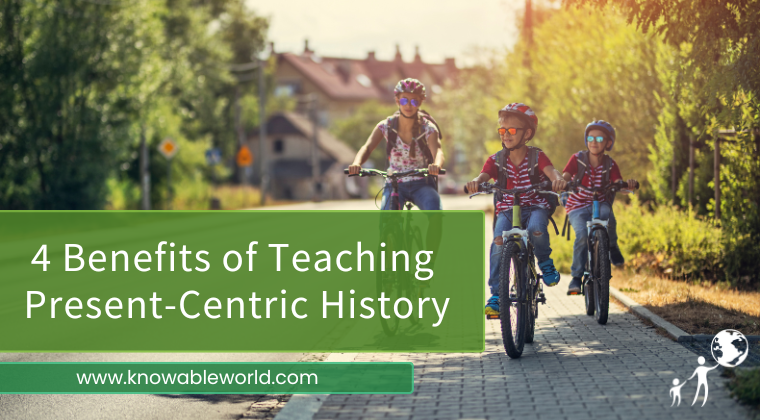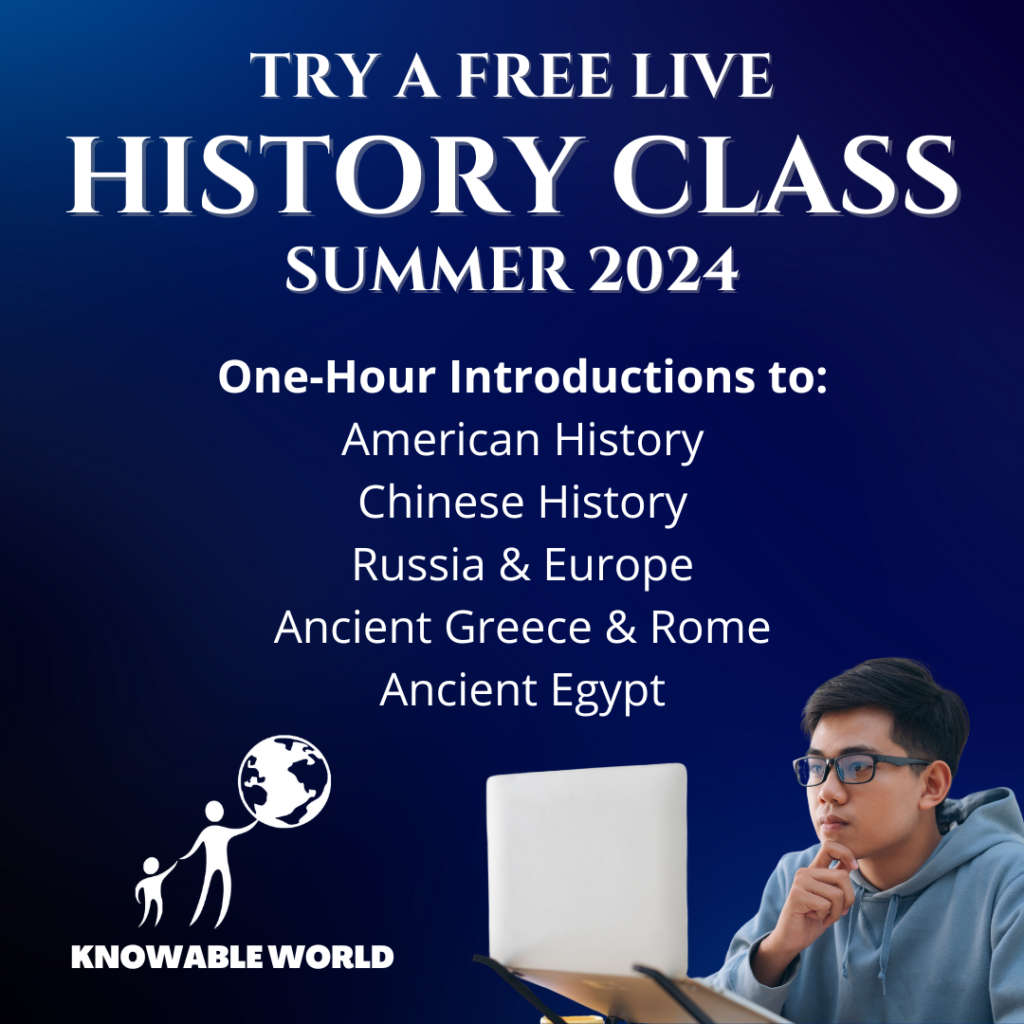Empower Your Kids With Practical, Relevant History They Will Remember

Many people think of history as a dusty and dry subject that they are all too happy to leave behind with their high school or college studies. But what if it didn’t have to be this way for your children?
Knowable World live classes and curriculum are built on an exciting new approach to history called “present-centrism”. No longer is history a boring subject filled with busy work and irrelevancies! Instead, we bring the past to life by showing students that the world they live in is one that has been shaped, in every way, by people and events from the past.
The great news for you, as a homeschooling parent, is that present-centric history is exactly what you need to equip your children with the knowledge and critical thinking skills to live successful and fulfilling lives.
What Is the Present-Centric Approach?
Developed by Knowable World co-founder, historian and teacher Scott Powell, the present-centric approach rejects the traditional idea of history as “the study of the past.” Instead, for us, history means looking at the world we live in now and building a historical awareness of how it has come to be the way it is. After all, we don’t live in the past! We are living in a present that has been shaped by history and that will one day be history to future learners.
All of the classes and curriculum at Knowable World reflect this present-centric approach. You can read more about this approach in Scott Powell’s book, The History of Now.
Let’s look at four huge benefits to your children of learning history using the present-centric approach.
1. Teach global history
The three-year rotation at Knowable World is not the classical rotation of Ancient, European, and American history. In 2024, we live in an interconnected, globalized world where students will interact with people from a wide range of countries and backgrounds. Students learn about ancient history as part of the background story of our modern world, but they also need to know about the histories of China, India, Africa, Russia, and other important and emerging actors on the world stage! The current three-year rotation is:
- Asia, Africa, and the World We Live In (2024–25 school year),
- Russia, Europe, and the World We Live In (next live classes in the 2025–26 school year), and
- America and the World We Live In (next live classes in the 2026–27 school year)
2. Tap into your student’s existing motivation
Nobody enjoys trying to “make” students do work they don’t want to do or learn things they aren’t interested in learning. With traditional approaches to history, some students are able to develop an interest (often in one narrow historical topic that they relate to personally in some way), but many others find it difficult to get excited about things that happened “long ago and far away.” They have a strong need to know, “Why do I need to learn this? Why does this matter?” Students deserve good answers to these questions!
With a present-centric approach to history, these questions are explicitly answered with each fact that is presented. We never ask students to learn anything that doesn’t directly help them to better grasp the whole narrative. At the end of the year, students will be able to explain not only the set of anchor facts they have learned and how they connect to each other, but also why they are important to understanding the world we live in today. It’s an integral part of our approach.
Children, especially at the elementary age, have an intrinsic interest in the world around them and are endlessly curious about it! History should be a reward for that curiosity. Each lesson should help them understand the world they live in a little bit better and leave them excited to learn more. That’s what the present-centric approach can give them.
3. Just the (important) facts, ma’am
One of the first things Knowable World students learn is the vocabulary word “plethora.” Plethora means “overabundance; excess; a large quantity or wide array; a lot” (dictionary.com). It means: Too much!
It’s easy to recognize that history is a plethora. There are simply too many facts—too many human lives, stories, and cultures—for anyone to learn about them all. Somehow, we must figure out how to present the most important facts to our children in the relatively small amount of time that we have to spend on learning history. But how can you determine which facts are the most important?
The answer present-centrism gives to this question is: The most important facts are the ones that have the most power to explain why the world is the way it is today. Students in the early grades learn a basic framework of the most important facts of world history. Each year, they begin again with this basic framework and continue to build their knowledge by adding more depth and detail.
4. Learning that lasts!
What do you get when you combine a motivated student with a focused presentation of important information that they can use in the real world? You get meaningful learning that lasts!
You might have had the experience as a student of cramming for an exam, getting a good mark, and later forgetting everything you thought you had learned. That’s what happens when students are presented with information that isn’t meaningful to them. They get the message that learning is something temporary, done just to pass a test, with no connection to life outside of school. Unfortunately, the subject of history is the one that students most likely associate with this experience.
When we change our focus from “learning about the past” to building a historical awareness of the world we live in, students begin to see how history matters. The subject becomes important to them, and the facts stick.
Conclusion
Our goal with Knowable World live classes and curriculum is to give students the knowledge and thinking skills they need to live effective, fulfilling adult lives. Parents will be happy to know that our students are well equipped to excel in college history classes, too! They have a solid framework of historical knowledge and have learned to engage thoughtfully with complex ideas, both in discussion and in written answers. Here is the experience of one graduate, relayed by his mother:
“BTW I don’t know if [my son] shared this with you already – but he called home a few days ago *thrilled* that he doesn’t have to study for his history class. He said he knew it all from your class!”
Sue, homeschooling parent from California
If you’re interested in learning more about how present-centrism makes it possible for you to give your students a whole new kind of history education, make sure to join our newsletter list because this won’t be the last article on this topic.
Want to try before you buy? Scott Powell is teaching several free live classes for grades 3-6 and 7–12. Try out a live history class this summer! Register your students here:

